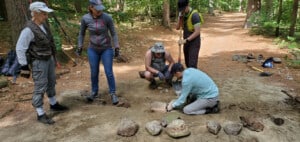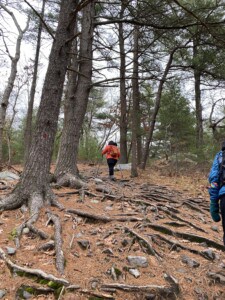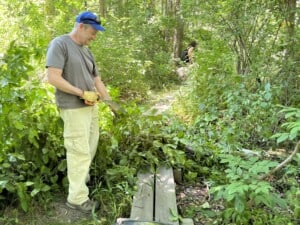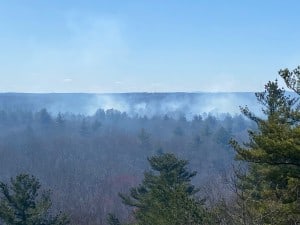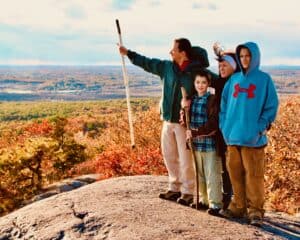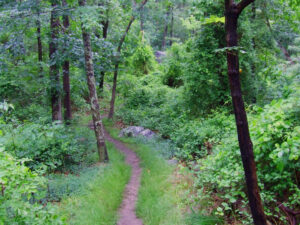Let John Walsh, a member of the Board of Trustees of the Friends of the Blue Hills, introduce you to our cold-blooded friends in the Blue Hills. John is a biologist and educator.
The mercury is falling, winter gales are rising, and balmy weather is an increasingly distant memory. Time to put on an extra blanket, turn up the thermostat and brew up a cup of hot tea before turning in for a blissful night’s sleep in preparation for hiking the snow laced trails of the Blue Hills.
Your initial chilliness is quickly replaced by warmth as shivering and muscular activity release soothing waves of heat. Ahhh,the pleasures of life as a warm-blooded, technologically advanced hominid. Technically known as homeotherms, we belong to a group of organisms that are able to maintain a relatively constant internal temperature. But how about those not so fortunate?
Cold-blooded organisms (poikilotherms)such as reptiles must rely on their management of the surrounding environment to help maintain their own internal environment. During the blistering heat of summer this may involve burrowing into the relatively cooler earth or being more active during the cooler nighttime hours. In the biting winters of in the temperate climes of Massachusetts it necessitates seeking shelter from the life-draining surface landscape.
Although the Blue Hills harbors a variety of reptiles that require such seasonal measures, two of the most intriguing involves species whose mutual existence is intertwined on several levels, including the copperhead snake (Agkistrodon contortrix) and the timber rattlesnake (Crotalus horridus). The names of these two, often misunderstood, venomous snakes typically evoke a variety of responses in people running the gamut from fascination to revulsion.
The copperhead usually runs 2-3 feet in length with a copper colored head, and reddish brown body accented by characteristic dark brown hourglass shaped bands which renders it both attractive and well-camouflaged. The copperhead can be found in a wide variety of habitats where it hunts a number of different small animals including rodents. Its prey is injected with venom that attacks the circulatory system. Although painful, the bite of a copperhead is rarely life threatening to a human. In fact, one of the active ingredients, contortrostatin, of copperhead venom, is currently being investigated for possible use in controlling the growth of some cancers. In addition, these top predators can help control the rodent populations that also act as hosts of the deer tick which carries Lyme disease.
Like the copperhead, the timber rattlesnake is also a pit viper, so named in recognition of having a pair of thermosensitive pits on both sides of its triangular-shaped head. These organs make them effective nocturnal predators, preying on many of the same small animals as their copperhead cousins.
Typically running from 3-5 feet, timber rattlesnakes vary considerably in color, although darker forms appear to predominate in more northerly and cooler settings. Typically reclusive and shy, these snakes readily retreat from potential danger employing their characteristic “rattle” when cornered or threatened.
In order to help survive the stresses of winter, both snakes often co-hibernate in deep clefts within rocky outcroppings. This communal denning helps both species retain essential body heat. Coupled with an already low metabolic rate and the relatively mild temperature beneath the ground, the snakes are able to survive the winter. The snakes typically reemerge in mid-April. Timber rattlesnakes, in particular, are most vulnerable at this time as they remain lethargic as they bask on the surrounding rocks for some period of time before migrating away from their denning site. This behavior makes them especially susceptible to collection or disturbance.
While both species are widely distributed, many populations have been extirpated or are experiencing significant declines. This is particularly acute in the Northeast where both species approach their northern range limits. In Massachusetts, both species can only currently be found in the Blue Hills, east of the Connecticut River valley and the Berkshires. In recognition of their precarious state, both snakes are listed as “Endangered” under the Massachusetts Endangered Species Act (MESA), providing them with certain protections.
The Friends of the Blue Hills is working with the Department of Conservation and Recreation to help protect these and other endangered species in the Reservation.
So as you hike or ski by a rocky ledge in the Blue Hills this winter, wish the possible tenants sweet dreams as, like us, they await the return of spring’s promise of life re-awakened and their return to their critical role in the ecology of the Blue Hills.



